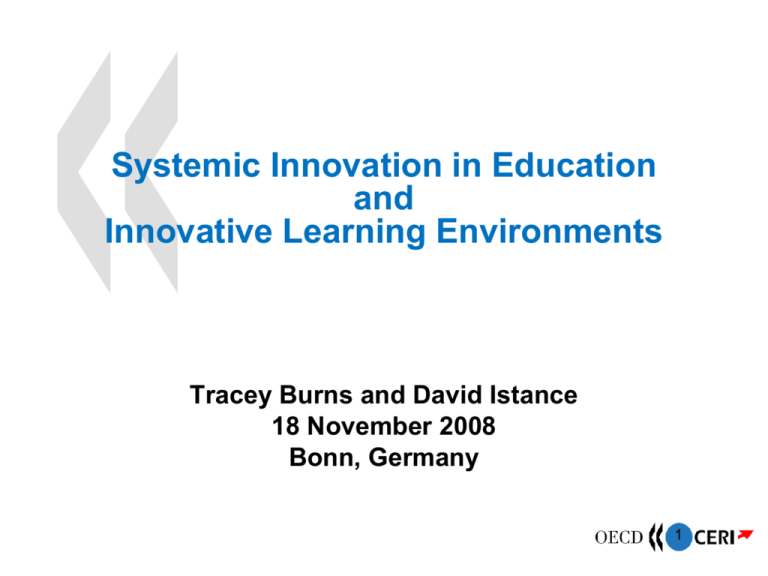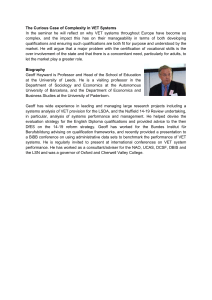Systemic Innovation in VET
advertisement

Systemic Innovation in Education and Innovative Learning Environments Tracey Burns and David Istance 18 November 2008 Bonn, Germany 1 Systemic Innovation in VET Project objectives Conceptualize innovation in education Focus on processes and dynamics of innovation in education (KM perspective): – Factors influencing innovation – A model of innovation Innovation strategies – Role of evidence – Monitoring and evaluating innovation – Measuring innovation 2 Innovation “the implementation of a new or significantly improved product (good or service), or process, a new marketing method, or a new organisational method in business practices, workplace organisation or external relations” »Oslo manual (2005, OECD/Eurostat) 3 Systemic Innovation in VET “Systemic innovation in VET is change that is introduced with the aim of improving the operation of VET systems, their performance, the perceived satisfaction of the main stakeholders, or all of them at the same time.” 4 Focus of the analysis profile of innovation use of an evidence base to support innovation process and dynamics of innovation role of evaluation in innovation 5 Identification of needs What are the drivers of change? Evaluation Development of the innovation Which stakeholders are involved? = judgement of outcomesIdentification top-down vs. bottom-up approach of needs base Knowledge Output of the innovation Development which stakeholders are involved? How and when is evaluation conducted? of innovation Evaluation Product Central role: interaction with different stages What criteria are used? What types of knowledge? Process Monitoring What are the findings? Tacit knowledge Marketing method Knowledge base Output = continuous surveillance of progress Explicit knowledge Organisational method Implementation process What knowledge sources? Monitoring How is monitoring conducted? Outcomes Without piloting:Implementation large-scale implementation What criteria are used? With piloting: = impacts or consequences of the innovation 1. Small-scale implementation Summative or formative purpose? Outcomes 2. Monitoring/evaluation Is there an ‘implementation gap’? What are the findings? 6 3. Scaling-up Case studies Australia: Increasing the status of VET; FLAG; Evidence base for VET Denmark: Globalisation Council; Practical training Hungary: Modular National Qualification Register; Step one forward Germany: Innovation Circle; SKOLA Mexico: Tech Bac Reform; Linking public and private resources Switzerland: Case Management; Leading Houses, Basic Commercial Training 7 Preliminary findings Drivers: Economic (e.g. Need to improve competitiveness, increase efficiency of public funding, globalisation and rise of new skill needs, etc) Social (e.g. provide a solution for school leavers, drop-outs, students not taken care within the previous VET system) Political (e.g. Need for a political move/success) Technological (e.g. new technology, etc) 8 Preliminary findings Barriers: Accountability mechanisms that radically restrict risk Competing policy agendas – Horizontal and vertical cooperation – Timing Lack of consensus among stakeholders – Ownership – Uptake and implementation – Resistance to change/fatigue Lack of research evidence and consistent evaluation – Timing/policy cycles – Blue sky research 9 Publication (mid 2009) A framework report on systemic innovation in education (concepts, mechanisms, influencing factors). A typology of systemic innovation in VET (case studies). A benchmarking report on good practice (emphasis on use of evidence for innovation policies). Lessons learned and recommendations from intercountry comparisons. 10 OECD-CERI Innovative Learning Environments David Istance Bad Honnef 18th November 2008 11 Where does it come from? Grown out of long-running CERI reflections on ‘Schooling for Tomorrow’ A strong focus on the organisation of learning, rather than the institutional variables of educational reform Focus on research and on concrete innovations (and less on futures thinking) Examples must be relevant for school-age learners – not the whole lifelong learning range 12 Innovative Learning Environments Project • • Exploratory Phase with Mexico “Innovating to Learn, Learning to Innovate” report (November 2008), another in pipeline • Three strands: i) Analytical, ii) Empirical , and iii) Policy • Open to countries, regions & other partners (foundations, business communities, cultural groups), including individual ILEs 13 Analytical Strand – new publication Syntheses of research findings from leading experts Each chapter will address: 1. How do students learn optimally? 2. How can teachers provide a favourable learning environment for learning? 1 The Historical Developments in the Conception of Learning Eric De Corte, Leuven University 2 Developmental and Biological Bases of Learning Kurt Fischer, Harvard University 3 The Cognitive Perspective on Learning Lauren Resnick (to be confirmed) 4 14 Analytical Strand: Publication (cont.) 4. Emotional and Motivational Aspects of Learning Monique Boekaerts, Leiden University 5 Technology and Learning Richard Mayer, University of California 6 Learning about real-world Problems Brigid Barron, Stanford University 7 Assessment for Learning Dylan Wiliam, University of London 8 Learning in Social Groups Robert Slavin, John Hopkins University 9 The Role of the Family in Learning Barbara Schneider, Michigan State University 10 The Community as a Resource for Learning Andrew Furco, University of Minnesota 15 Learning Environments Micro-level – teaching and learning in context – not schools per se (collections of learning environments) May be found in schools or in other settings Multi-site (not single classes or individuals) Concrete examples, not just theoretical (but may be underpinned by formalised approaches to teaching and learning) 16 Innovative Learning Environments (for OECD/CERI project) are: Departures from the traditional approach of most general or vocational education to respond better to learning needs – they are innovative They serve the learning needs of children and/or adolescents (319 years), exclusively or with others Seek to provide optimal learning and development in cognitive, meta-cognitive and socio-emotional terms, whatever the curriculum focus Aim at a broad set of learning and educational needs, not very specific types of knowledge and capabilities 17 Empirical Strand A universe of ILEs from as many countries as possible (200-400), recorded to standard format • An Inventory 40-50 • Observatory with 10 - cases, looking at the conditions under which ILEs get started, develop, & are made sustainable (2009) 12 cases representing different types of ILE, “thick” in-depth case studies on learning process in context (2009- 2010) 18 One important avenue is “research-based innovation”… “There are innovations in education, but neither the profession nor the public at large looks to research to produce them. Instead, they are expected to come from imaginative practitioners and from outside sources such as technology companies… “’Research-based innovation’ is research aimed at creating innovation. The criterion is fruitfulness – does the idea have potential? Is it worth developing further? It depends crucially on understanding the nature of the problem”. Carl Bereiter and Marlene Scardamalia in Innovating to Learn, Learning to Innovate, OECD/CERI, 2008 19 …while protecting the public dimension of educational knowledge and application “A possible outcome would be the emergence of ‘educational tool companies’ at the interface between public educational research and schools. These companies would heavily rely on patenting educational methods in order to generate income by granting licenses to schools.” (Innovation in the Knowledge Economy: Implications for Education and Learning, OECD/CERI 2004: 89) 20




